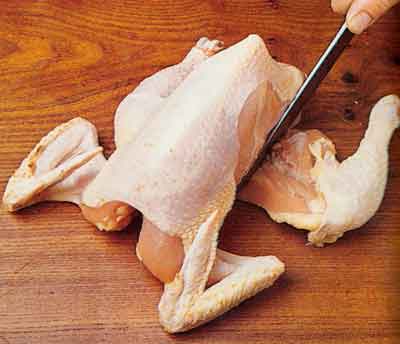Poultry pieces purchased from a butcher or supermarket are sometimes poorly trimmed and, pound for pound, are usually more expensive than a whole bird. By learning how to cut up poultry at home, you can save money and also provide neater looking, more appetizing portions. There is a bonus, too, in the giblets that come with a whole bird.
The process is simpler than it looks. Approached with confidence, it can be accomplished in only a few minutes. All you need are a chopping board, a heavy, sharp-edged chefs knife and educated hands. Learn to locate the joints by feel so that, when you bear down on the knife, you avoid the bones and cut through the less resistant tendons and cartilage.
On these pages, a chicken is used to demonstrate the technique but, since all birds have the same basic anatomy, you can adapt the steps to cut up duck, turkey and other poultry.
⇓ You may also listen to the instructions by pressing the play button below
INSTRUCTIONS
Removing the Legs:

Place the chicken, breast side up, on a board. Pull one leg away from the body and cut through the skin between the body and both sides of the thigh. Now bend the whole leg firmly away from the body until the ball of the thighbone pops from the hip socket. Cut between the ball and socket, and the leg will come away. Repeat with the other leg.
Dividing the Legs:

Place each whole chicken leg in turn on the board, skin side down, and cut firmly down through the joint between the drumstick and thigh to separate the two pieces. If the bird is a very small one, you may omit this step.
Removing Wings:

Press the top bone of one wing against the bird’s body so that you can feel the shoulder ball-and-socket joint. Make an incision between the ball and socket, then pull the wing away from the body (right) and cut down through the skin at the base of the wing. A thin slice of the breast meat will come away with the wing. Take off the other wing the same way.
Halving the Carcass:

Put the knife blade into the cavity of the bird from the tail end and pierce the thin area bounded by the shoulder joint, collarbone and rib cage. Cutting carefully toward yourself and parallel to the backbone, slit the bones of -he rib cage. Repeat the same cut on the opposite side of the bird’s backbone.
Removing the Breast:

Pull apart the breast and back to expose the meat-covered shoulder blades that join them. Cut down through these bones to detach the breast section. Next, divide the back into two pieces by cutting across the backbone at the point where the rib cage of the chicken ends.
Halving the Breast:

Place the breast skin side up on the chopping board. Using a strong, steady pressure on the knife, cut down the length of the breastbone to separate the breast into two pieces. The breast halves of large birds, such as turkeys or geese, can be cut across to yield four to six breast portions.
Pieces For Every Purpose:

The quick, efficient way to disjoint a bird produces the 10 pieces shown above. The diagram identifies the location of each piece on the bird. Drumsticks (A) and thighs (B) provide four sections; the wings (C) two. The back (D and E), cut crosswise and the breast (F), divided lengthwise, will produce four more. The meaty breast, thighs and drumsticks are choice pieces for broiling, frying and braising. The bony wings may also be broiled or fried and, like the back, make excellent material for stocks, or may be added to a braise.
The Bones of a Bird:

The first bone you will feel in a bird’s breast is the wishbone; cartilage joins its apex to the breastbone and its tips to the collarbones on either side. Cartilage also connects the collarbones and shoulder blades. The rib cage, backbone and breastbone form the body. Ball-and-socket joints link legs to body, and the wings to the collarbones and shoulder blades.
BONUS CHICKEN RECIPE

